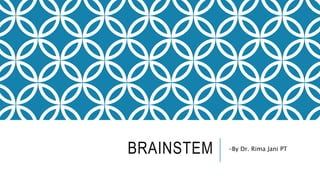The midbrain connects the brainstem to the forebrain and cerebellum. It consists of the tectum and cerebral peduncles. The tectum contains the superior and inferior colliculi, which are involved in visual and auditory reflexes. The cerebral peduncles contain the substantia nigra and red nucleus. The red nucleus receives input from the motor cortex and dentate nucleus, and sends outputs to control muscle tone, complex movements, righting reflexes, and eye movements.














































